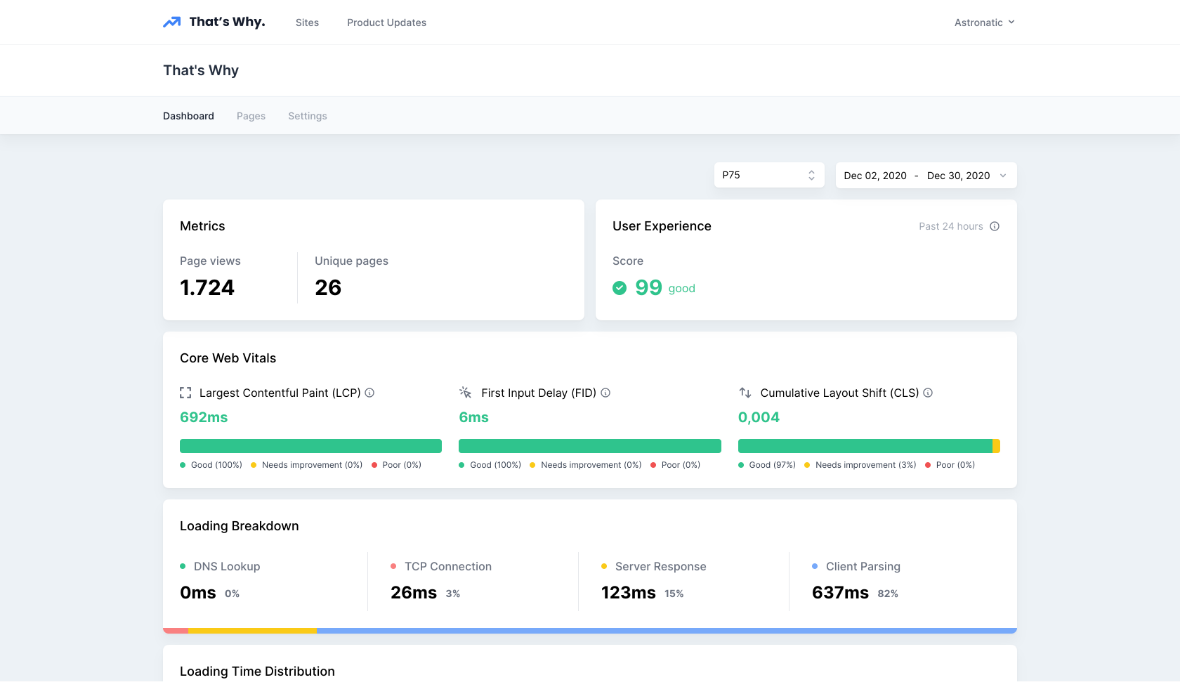What is Real User Monitoring?
Monday 14th of December 2020
You might have seen a new trend in the web development world. Real User Monitoring (RUM) is trending, finally! With this blog post we’ll do a deep dive into what RUM is and how you can use it to improve user experience which can lead to decreased bounce rates and increased conversions.
If you want the TLDR:
Real User Monitoring (RUM) is a passive way to monitor the performance and user experience of a website by collecting and reporting performance data of the website’s real users.
Why should you use Real User Monitoring?
Finding out how users experience your site is the best way of making targeted improvements that benefit all users. The only way to do this is to get feedback from your users. This means doing interviews or letting them fill in a form which you will need to review, this is very time-consuming and not an effective way of measuring user experience. That’s where Real User Monitoring comes in.
Real User Monitoring, also known as RUM, is used to measure the experience users have on your website. With RUM you measure these experiences through various JavaScript APIs like the Core Web Vitals and Timing APIs. We’ll dive into those later on.
These technical measurements give you detailed insights on the performance and user experience of each individual page on your website. These insights help tremendously with making targeted improvements, which in turn leads to lower bounce rates and higher conversion rates.
The impact of performance
A bad performing website can have a huge impact on bounce rate, conversions and sales. A study by Google shows that there can be major increases in revenue by lowering page load. Sometimes even as much as a 12% increased revenue.
How does Real User Monitoring work?
Real User Monitoring is called a passive approach to website performance monitoring because it only uses the data provided from actual website visitors. This is done through various techniques. One of the most used techniques is using the Beacon API from JavaScript . With the Beacon API it’s possible to collect data during a page visit and send it when a user leaves the page. This can be switching to another tab or clicking on a link to another page.
After the user leaves the page the Beacon will be sent asynchronously. This means it has no impact on the performance of your page.
Now you might be wondering, what data do you collect with real user monitoring? To answer that question we have to look at how user experience can be defined through only technical measurements. Google has researched this and concluded that 3 of the 5 Web Vitals are Core Web Vitals which are a technical definition of user experience.
What are Web Vitals?
To learn more about the Web Vitals you can read our other blog post about how Core Web Vitals will affect SEO in 2021
What is the difference between Real User Monitoring and Synthetic Monitoring?
Synthetic Monitoring is testing a page of your website with a tool to detect issues. One of the tools out there is Lighthouse by Google. Lighthouse is a tool that can visit your website page, does a technical analysis and gives you a report on what is performing well and what needs improvement.
This is a good starting point to optimize pages. However, this requires active monitoring meaning you have to keep using Lighthouse every time something on your website changes to ensure the performance is just as good or even better. Even worse, you need to do this for all of your pages, who’s got time for that? It also does not account for real users. Lighthouse is just a tool, it’s not a real user.
Real users have different scenarios thus different experiences. They can have fast phones, slow internet, slow laptops, they might be using very good wifi or laggy 3G. This is different for every user that visits your website. A tool like Lighthouse can’t measure their user experience.
Real User Monitoring ensures that you can get insights into the experience of every user.
Now don’t get me wrong, Lighthouse is a great tool to detect issues. It’s just a lot of work if you want to use it proactively. That’s Why ;) a combination of Synthetic Monitoring and Real User Monitoring is a very good idea. You can use RUM to detect user experience issues and then use Lighthouse to check if the page has any technical issues that can be easily resolved. If Lighthouse isn’t enough you can use the detailed reports from a RUM tool to find the underlying issues.
How to use Real User Monitoring?
To get started with Real User Monitoring you can use That’s Why. We offer a one-line integration, a free trial (no credit card needed) and very detailed analysis, reports, charts and advice.
Test Real User Monitoring for free here.
